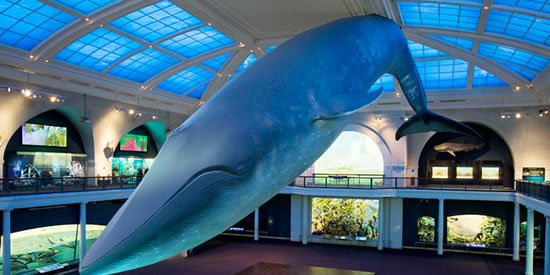Degrees Awarded At American Museum Of Natural History
By Sybil Maimin

Graduation at AMNH takes place under the Giant Blue Whale
The American Museum of Natural History (AMNH), beloved locally and admired internationally for its wondrous dioramas of majestic animals in native habitats, giant dinosaurs, and Planetarium explorations of the universe, is also an important degree granting educational institution. Through its Richard Gilder Graduate School, the museum awards both the Ph.D. and the MAT (Master of Arts in Teaching). The doctoral program in Comparative Biology, the first museum Ph.D. degree program in the Western Hemisphere, began in 2006. The MAT Earth Science program, begun as a pilot project in 2011 and given degree-granting authorization by the New York State Board of Regents in 2015, is also the first of its kind for a museum. In a proud and beautiful October commencement ceremony held beneath the 94-foot long Atlantic blue whale suspended in the museum’s Milstein Hall of Ocean Life, five Ph.D. and fifteen MAT degrees were conferred. In addition, honorary degrees were given to Gilberto Silva Taboada, curator emeritus of the Natural History Museum of Cuba who is a renowned expert on Caribbean bats and champion of U.S--Cuban scientific collaboration, and John B. King, Jr., U.S. Secretary of Education and, previously, as New York State Commissioner of Education, a key supporter of the museum’s MAT program. In remarks stressing, “science knows no country,” museum president Ellen V. Futter announced an exciting new exhibit, “Cuba,” developed jointly by AMNH and the Natural History Museum of Cuba, “an important milestone for American and Cuban museums.”
Ph.D. candidates drew upon AMNH massive collections, worked with some of its 200 scientists, and did extensive field work in distant places. Dissertations range from studies of frogs in New Guinea to vision systems of scorpions across Southeast Asia. Graduate Bernardo Santos even had the aid of sixth graders studying science in the Bronx who helped him name a new species of parasitic wasp, Necolinoceras laluzbrillante. New Ph.D., Stephanie Loria of Queens, explained she always wanted to be a scientist and visited the museum often during her junior year of high school. Accepted into its Science, Research, Mentoring Program (SRMP), she came to the museum after school 1 to 2 times a week, engaged in a project on flamingos, “had lots of fun,” and will now be studying for a post-doctorate at the California Academy of Sciences in San Francisco.
The MAT program answers an urgent need for more science teachers. Degree candidates must be residents of the United States and commit to teaching in New York State for four years. The 15-month program is fully funded and prepares teachers in earth and space science for grades 7 to 12 in high-need schools. New Jersey native Maya Pincus, who visited the museum as a child, learned of the MAT program through a Google search. She is already teaching at the Urban Assembly School for Criminal Justice and reported, “This program has prepared me beyond belief.” MAT recipient Arthur Funk, who is teaching earth and agricultural science at Lehman College’s Celia Cruz High School, explained he designs his classes to include lessons on climate change and food sources, subjects “outside the standard curriculum but necessary for future voting citizens to understand.” His goal is not to give answers, but “to get his students to think about difficult questions.” The museum program, said Funk, is “top notch.” MAT candidates spend four days a week co-teaching in a city school, and all-day Saturday studying at the museum. Pincus taught with Stephen Riemersma at Brooklyn’s Midwood High School. Impressed with the program, master teacher Riemersma explained that he received support and access to resources from the museum. The program, he reported, is “much more comprehensive than ones from other colleges. It is very immersive.” The MAT program has already produced 50 graduates who are teaching in high need schools around the state, including in New York City.
At the commencement, special recognition was given to Maritza Macdonald, the special director of education policy, who is retiring in January after twenty years of service at the museum. She was cited for “her enormous contributions to science education at the museum and internationally.”#
